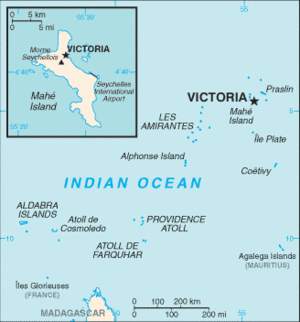Seychelles: Difference between revisions
imported>Graham Harris (history) |
imported>Graham Harris (history, expand) |
||
| Line 7: | Line 7: | ||
The Seychelles have been known to seafaring people in the area long before permanent settlments appeared. Arabs charted the islands in the 9th and 10th centuries, as did Portuguese explorers in 1505. In 1609, Alexander Sharpeigh of the [[British East India Company]] landed on the islands and found them uninhabited. <ref name= Pre_Settlement> [http://www.virtualseychelles.sc/pecu/pecu_his_preset.htm Pre settlement history], Republic of Seychelles website</ref> | The Seychelles have been known to seafaring people in the area long before permanent settlments appeared. Arabs charted the islands in the 9th and 10th centuries, as did Portuguese explorers in 1505. In 1609, Alexander Sharpeigh of the [[British East India Company]] landed on the islands and found them uninhabited. <ref name= Pre_Settlement> [http://www.virtualseychelles.sc/pecu/pecu_his_preset.htm Pre settlement history], Republic of Seychelles website</ref> | ||
<ref>Jourdain, John-William Foster; ''Journal of John Jourdain'' from the ''Ascension'', A British East India Company ship piloted by Sharpeigh; First published 1905, Cambridge</ref> | <ref>Jourdain, John-William Foster; ''Journal of John Jourdain'' from the ''Ascension'', A British East India Company ship piloted by Sharpeigh; First published 1905, Cambridge</ref> | ||
Lazare Picault explored the islands in 1742, and the Séchelles were officially annexed by France in 1756 and named after French minister of finance under King Louis XV, Jean Moreau de Séchelles (1690-1760). The French created a supply outpost that grew crops and harvested natural resources, decimating the giant tortoises population and hardwood forests. | |||
The Seychelles during this time were dependant on [[Mauritius]], and after a lengthy struggle with Britain, possession of both was ceded by France in 1814. In 1903 The Seychelles becam a British Crown Colony, ending their political connection to Mauritius. | |||
The colony gradually moved towards independance during the 20th century; in 1948 a Legislative Council was created; in 1970 a new constitution was adopted; and in 1975 the first self-government was created, with James R. Mancham the first president and France-Albert René the prime minister. | |||
France-Albert René became president in a [[coup d'état]] in 1977, and by 1979 the Seychelles became a one-party socialist state, with the Seychelles People's Progressive Front (FPPS) in power. A new constitution was created and free elections held in 1993. In 2004 René, in power since 1977, stepped down and the current presedent, James Michel, became both the chief of state and head of government. | |||
==References== | ==References== | ||
Revision as of 20:23, 2 June 2007
The Republic of Seychelles is an island nation in the Indian Ocean. The archipelago lies northeast of Madagascar and 1,000 miles east of Kenya. With a population of 80,000, it is the smallest sovereign African nation. Most citizens are of mixed French and East African ancestry.[1]
History
The Seychelles have been known to seafaring people in the area long before permanent settlments appeared. Arabs charted the islands in the 9th and 10th centuries, as did Portuguese explorers in 1505. In 1609, Alexander Sharpeigh of the British East India Company landed on the islands and found them uninhabited. [2] [3]
Lazare Picault explored the islands in 1742, and the Séchelles were officially annexed by France in 1756 and named after French minister of finance under King Louis XV, Jean Moreau de Séchelles (1690-1760). The French created a supply outpost that grew crops and harvested natural resources, decimating the giant tortoises population and hardwood forests.
The Seychelles during this time were dependant on Mauritius, and after a lengthy struggle with Britain, possession of both was ceded by France in 1814. In 1903 The Seychelles becam a British Crown Colony, ending their political connection to Mauritius.
The colony gradually moved towards independance during the 20th century; in 1948 a Legislative Council was created; in 1970 a new constitution was adopted; and in 1975 the first self-government was created, with James R. Mancham the first president and France-Albert René the prime minister.
France-Albert René became president in a coup d'état in 1977, and by 1979 the Seychelles became a one-party socialist state, with the Seychelles People's Progressive Front (FPPS) in power. A new constitution was created and free elections held in 1993. In 2004 René, in power since 1977, stepped down and the current presedent, James Michel, became both the chief of state and head of government.
References
- ↑ The World Factbook, Seychelles, CIA (2007)
- ↑ Pre settlement history, Republic of Seychelles website
- ↑ Jourdain, John-William Foster; Journal of John Jourdain from the Ascension, A British East India Company ship piloted by Sharpeigh; First published 1905, Cambridge
